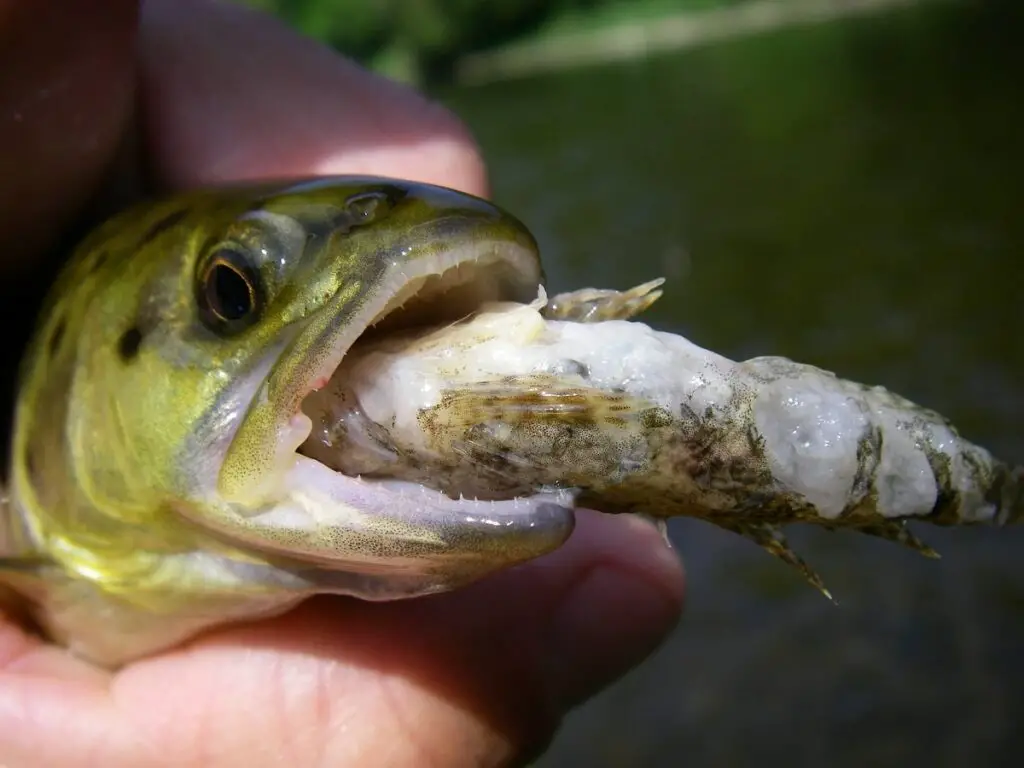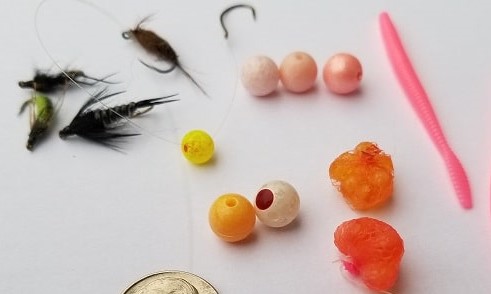Best Baits For Trout: A Top Guide Rates All Baits

I have been fishing for trout for over 37 years, and I have been one of the top trout guides in my area for over 20 years. During this time, I have tested just about every bait used for trout in all seasons and conditions.
My opinions on baits are based on 37 years of experience and extensive testing of baits, and landing thousands of trout, not to mention the intel from many other guides and experienced anglers. I have tested baits on all the species I guide for, which include brown trout, brook trout, rainbow trout, and lake trout.
In my opinion, all species of trout like the same baits.
In my experience, there are two types of trout baits. They are high-percentage baits and low-percentage baits.
Most anglers do not know the difference between the two, which leads to anglers wasting time, money, and fewer fish landed.
A high percentage bait is a bait that most trout will eat, and they will eat it most of the time. A low-percentage bait is a bait that only a small percentage of fish will actually bite, or it’s a bait they will only bite sometimes.

I can tell you for a fact that the baits being used by top trout guides are often different than what the average angler or new angler uses. I can also tell you that good trout guides have figured out what works and what doesn’t., so you should trust them and use the same baits that they do. Good news, I’m going to tell you what those baits are.
I scoured the chat forums and other websites to find out what people are recommending as the best baits for trout. This is a curated list of trout baits.
- Hellgrammites: (High Percentage Bait).
- Powerbait Dough: Garlic scent or Corn Scent, mentioned by several users as equally effective as worms.
- Powerbait Mice Tails.
- Wax Worms: Noted for their effectiveness by one user (High Percentage Bait).
- Night Crawlers and Dew Worms: A commonly recommended bait, with multiple users agreeing on its effectiveness. (Only the smaller worms are a high percentage bait).
- Salmon Eggs or Cured Salmon or Trout Eggs: Specifically, the Pautzke brand Ballz Of Fire is recommended. (High Percentage Bait).
- Corn – Should never be used as bait.
- Marshmallows and dried hard Marshmallows – Very low percentage bait.
- Meal Worms and Grass Hoppers: Mentioned as sometimes effective but not always worth the effort to obtain. (High Percentage Bait)
- Bread: Anglers squish it hard, roll it into a dough ball, and put it on a hook.
- Mad River Trout Worms: (High Percentage Bait – Rivers Only).
- Shrimp: Recommended by a user who also prefers artificial lures like rooster tails or tiny jerk baits.
- Crickets (High Percentage Bait)
- Huhu Grubs: Endemic to New Zealand (Grubs are a High Percentage Bait).
- Green Power Eggs
- Black and Gold Tobys: (not actually a bait) This spoon was recommended by a user from New Zealand, highlighting the effectiveness in that region.
- Powerbait Trout Nuggets (best for freshly stocked trout).
- Spinners: (not actually a bait, it’s a lure) Noted for their effectiveness, with one user mentioning.
- Trout Magnets: Anglers claim this is a decent bait option.
- Parachute Adams: An artificial dry fly.
- Rebel Wee-Crawfish: Not a bait, it’s a lure!
Most of the baits being recommended on that list are low-percentage baits, and even with my extensive knowledge of how to catch trout, if I were to start using most of those baits, even I would catch less trout! So, imagine what happens when less experienced anglers use them.
If you ask experienced trout guides what their most effective baits are, you will get a list of baits that looks more like this.
1. Garden Worms
Garden worms or even small dew worms, ones that are 2 to 4 inches long. Includes red worms or red wigglers. (not dew worms).
In lakes and rivers, this is often one of the most effective baits for trout.
Do not ball up your worm on the hook!! Hook in once or twice through the fat part of the worm, let it hang naturally, and then learn how to lob-cast it.
Pro Tip: Many new anglers use bad hooks or the wrong size hook for the bait they are using!

Trout guides are very picky about the hooks we use because we know that certain hooks have a much better hooking and holding percentage.
See my 4 Best Hooks For Trout article, which also talks about how to rig your hook and how to choose the right size based on your bait.
2. Insects

Despite some websites that claim large trout stop eating insects, I and my clients have caught thousands of small and large trout on insects. Other guides will tell you the same thing.
Aquatic insects such as Hellgrammites, Stoneflies, Caddis, as well artificial flies that fly anglers use are all good. You can also use artificial flies with spinning rods under a float or with a weight.
Terrestrials, which are beetles, crickets, grasshoppers are also good. Use a size 10 to 14 hook.

In rivers, I catch more large and small trout on flies than most other baits.
3. Minnows: Live and Dead

Minnows include whatever type of baitfish the local bait shop sells in the 2 to 4 inches length. Live minnows work everywhere.
Preserved minnows, salted minnows, dead minnows are all good in both lakes and rivers.
4. Grub Type Baits
Grubs, which include typical garden grubs, wax worms, maggots, or mealworms will work in rivers or lakes. (artificial grubs can be very good in rivers)
5. Real Fish Eggs

Fish Eggs include real salmon or trout eggs, either single eggs or tied into a spawn bag. These are great in spring and fall when the trout are spawning, but they can also be good in the summer months.
Often best in rivers, however, at times these can be good in lakes.
6. Leeches
Live leeches are very effective for trout. They are hard to resist especialy if they are hooked in the end so they are left alive and wiggling.
Artificial leeches like the Berkely Gulp Leeches are also good in rivers.
Crayfish / Crawfish

Call them what you will, Crayfish are a natural food source for all trout and therefore a good bait. I prefer to use smaller 1 to 2-inch crayfish and hook them in the tail so they stay alive.
Trout Beads

Both hard and soft trout beads are very good egg imitations that work very well in rivers.
Do not use them in still water such as lakes and ponds.
Plastic Trout Worms

Imitation plastic trout or steelhead worms are one of my most consistent and most effective baits for trout in rivers.
I do very well with the pink color, but red and brown can also be very good.
These do not work well in lakes, ponds, and reservoirs.
My List Of The Best Baits For Trout
This list of what I would consider high percentage trout baits is not in order from best to worst and is. There are times when one bait will work better than another bait. This is why I always have an assortment of baits with me.
The river conditions, feeding habits of the trout, the natural forage, will all be factors that determine what baits work and which ones don’t work.
Conclusion

Trout will eat anything that resembles food. They really are not that smart. I have caught trout on bubblegum, candy, a piece of styrofoam from a coffee cup, and even a chunk of bark. Just because you catch a fish on a bait doesn’t mean it’s good bait!
90% of the time, I use high-percentage baits to ensure my clients catch the maximum amount of trout possible, and so should you!
Once I have thoroughly fished a spot with my top high-percentage baits I might experiment with something like a power bait or other low-percentage bait.
Graham






